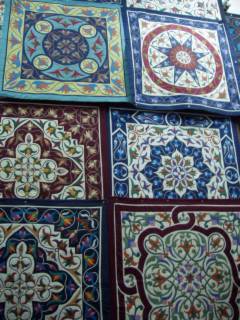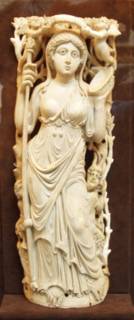Saturday's visit to the University of Oregon's newly refurbished museum found me fascinated by two artists -- Kiki Smith and Rick Barstow. I cannot remember what the docent said about Kiki Smith's The Blue Lake because the image was so compelling. I was drawn immediately into the ferocious gaze of the main figure, the distortions, the compelling sense the brown hair was the earth and the woman herself, her body was the lake. Was the painting a mediatation inward, blue the color chosen to remind us of death, of drowning?
The second artist, Rick Barstow, had intrigued me on my first visit because the painting was so dramatic, a deer (?) head affixed to a male torso, intense colors, no arms, helpless but why? Echoes of the Green Man myth perhaps? The docent added that not only was Barstow a Native American artist, but that he was a Vietnam vet. Transformations. Uniquely male view.
Immediately I jumped to the net to explore more of both of these artists. Kiki Smith is already well established, showing at MOMA in New York, but Rick Barstow also has a New York presence in SoHo. I haven't had time to write about what I learned, but I appreciate being able to see more than one work by these two artists, for their interests, ideas and creativity are inspirational, challenging, and compelling.
Kiki Smith at MOMA: http://www.moma.org/exhibitions/2003/kikismith/
Exhibits: http://www.artseensoho.com/Art/PACE/smith97/smith1.html and http://www.varoregistry.com/smith/
Rick Barstow art and statement on being a Native American artist http://members.aye.net/~kacf/Bartow.html NPR Interview http://www.npr.org/programs/talkingplants/features/2003/bartow/
A Time of Visions: http://www.britesites.com/native_artist_interviews/
Barstow at the Froelick Gallery, Portland OR http://www.froelickgallery.com/Artist-Detail.cfm?ArtistsID=227
Interview at: http://www.jca-online.com/ksmith.html
Tuesday, April 19, 2005
Tuesday, April 05, 2005
It's Tuesday morning. Help! I need a reminder as to why I should like Lord Byron. I know he's considered a great Romantic poet and is revered by the Greeks for his support of their drive to nationalism, but I see his life glorified, and I just get mad.
Here's a man who created himself, not a bad feat. Born with a club foot and overweight, teased dreadfully as he was growing up, he retired to his estate, lived on crackers and water, and then surrounded himself with a coterie of freinds who gathered at wild parties, complete with dancing girls and drinking wine from a skull's head.
When his early poems were published, he became the darling of society. Women were drawn to his beauty and his passion (as well as his nobility), and it didn't matter to him that they might be married or innocent. In fact, he considered women an ornament -- women should not eat in public, he said, it mars their beauty. His liaisons contributed to his death as well; hailed as a hero for going to Greece in a time of their war for independence, he was caught in a rain storm while travelling to be with his married lover, caught a severe cold and died.
Some of the lines of his poems echo in my heart. When I was younger, I idolized him. Today, I see the context of his life and realize how many men patterned their behavior and attitudes toward women after him. So I take it nearly as a personal affront.
Fiero's treatment of Byron is far too sympathetic. She says he was
"alienated from society" (35) and that he was fascinated by the myth of Prometheus "as a symbol of triumphant individualism". My point is he made choices; Prometheus acted for the good of humanity, stealing fire/knowledge from the gods. But Byron's fire is passion without integrity. I have the feeling I'm not being fair. Give me a reason to care again about Byron. Beth
Source: Gloria K. Fiero, The Humanistic Tradition, Vol 5: Romanticism, Realism and the 19th Century World. McGraw-Hill, 2002.
Here's a man who created himself, not a bad feat. Born with a club foot and overweight, teased dreadfully as he was growing up, he retired to his estate, lived on crackers and water, and then surrounded himself with a coterie of freinds who gathered at wild parties, complete with dancing girls and drinking wine from a skull's head.
When his early poems were published, he became the darling of society. Women were drawn to his beauty and his passion (as well as his nobility), and it didn't matter to him that they might be married or innocent. In fact, he considered women an ornament -- women should not eat in public, he said, it mars their beauty. His liaisons contributed to his death as well; hailed as a hero for going to Greece in a time of their war for independence, he was caught in a rain storm while travelling to be with his married lover, caught a severe cold and died.
Some of the lines of his poems echo in my heart. When I was younger, I idolized him. Today, I see the context of his life and realize how many men patterned their behavior and attitudes toward women after him. So I take it nearly as a personal affront.
Fiero's treatment of Byron is far too sympathetic. She says he was
"alienated from society" (35) and that he was fascinated by the myth of Prometheus "as a symbol of triumphant individualism". My point is he made choices; Prometheus acted for the good of humanity, stealing fire/knowledge from the gods. But Byron's fire is passion without integrity. I have the feeling I'm not being fair. Give me a reason to care again about Byron. Beth
Source: Gloria K. Fiero, The Humanistic Tradition, Vol 5: Romanticism, Realism and the 19th Century World. McGraw-Hill, 2002.
Thursday, February 10, 2005
So, the challenge of today to talk about plagiarism and scholarly integrity! Ha! I feel like Don Quixote tilting. The ease of access to so many fine ideas provides much temptation to my students who copy and paste with abandon -- and then freewrite. So, today, using the fantastic paintings of Hieronymous Bosch and the crackpot theory that a viewer can possibly tell if a Catholic Reformation or Protestant rebellion is coded in these 15th and 16th Century paintings, we shall explore the issues of plagiarism. More later!
Monday, February 07, 2005

Detail of wall hangings, Street of the Tentmakers, Cairo, Egypt.
Tonight I'm feeling just a little recovered from the awful cold that's going around and getting ready to read a set of papers. First, what are these wall hangings? These hand-sewn applique quilted hangings, roughly 3 x 4 feet, are crafted in small open-air shops along the Street of the Tentmakers in Old Cairo.
Here, in the space of a roughly 8 x 10 workspace/shop, 2 or 3 teenaged boys will sit cross-legged, under the eye of the shop manager, and spend their day stitching traditional Islamic designs backed with canvas. Once the tentmakers along this street served the carvans along the famed Silk Road with colorful tents; today, some shops specialized in larger, brilliantly colored, sheet-sized quilts to decorate weddings, restaurants, or a butcher's shop.
The Street of the Tentmakers is just far enough away from tourist tours to be quiet, yet the workmanship is exquisite. The young men were pleased to have their work praised; I knew from the high unemployment rates that they were also pleased to have a job, for we often met cabdrivers with university degrees. We were able to bring just one small hanging home to treasure.
The traditional Islamic designs carry more meaning than I've been able to decipher. I can see the repetition, the geometric "frame and meander" that is traditional. Almashriq's article says the designs come from the mosaic floors in medieval mosques, where design is not left to chance.
For more historical background and more detailed pictures, see this site: http://almashriq.hiof.no/egypt/600/670/677/cairo_tentmakers/
For more pictures of a traditional shop, see: http://www.touregypt.net/featurestories/applique.htm
but now it's truly time to read papers!
A question I've never been able to answer is how do we justify such differences in the standards of living in our world?

Wednesday, January 26, 2005

Detail of Ariadne, with satyr and winged cupids, from Constantinople, 6th Century. Ivory miniature (about 5" tall), Museum of Middle Ages, Paris. This beautiful little miniature is fascinating for its sad expression and mixture of Byzantine and classical elements. So is this Ariadne AFTER she's abandoned by Theseus? Note she's holding a staff (symbol of power or healing?) and a bowl (allusion to water?), with one breast exposed (reference to Amazons?). Many miniatures of this period and place (Constantinople) were of the Christ or religous themes, but here we find a classical theme, retelling the famous story of Ariadne, the woman who told Theseus how to find his way through the labyrinth, following her thread. His mission: to kill the dreaded Minotaur, ending the annual sacrifice of 7 pairs of maidens and young men, tribute from Athens to Knossos, also marking the shift of political power from the island of Crete to Greece.
Today is a quiet day, with many papers to read. Tomorrow we talk about Mesoamerican culture in humanities; perhaps that's the connection for we always wind up talking about human sacrifice. Time for tea. Beth

Tuesday, January 18, 2005
 ROMAN BATHS, BATH, ENGLAND. No one's allowed to go bathing now in these Roman baths, used for many hundreds of years by priests, royalty, and later, the aristocracy. When Rome pulled out, the baths were taken over by the locals and preserved. What amused me most were the many offerings to the gods made here, so that bathing was much more spiritual than today. And curses! "A plague be visited on the foul unmentionable one who took my toga!" These curses were etched on tiny tin or copper scrolls and then tossed into the pools as an offering to the goddess, along with coins. And, in an inner room, a large pool completely enclosed was reserved for the priests and for healing. A niche held a statue of the goddess.
ROMAN BATHS, BATH, ENGLAND. No one's allowed to go bathing now in these Roman baths, used for many hundreds of years by priests, royalty, and later, the aristocracy. When Rome pulled out, the baths were taken over by the locals and preserved. What amused me most were the many offerings to the gods made here, so that bathing was much more spiritual than today. And curses! "A plague be visited on the foul unmentionable one who took my toga!" These curses were etched on tiny tin or copper scrolls and then tossed into the pools as an offering to the goddess, along with coins. And, in an inner room, a large pool completely enclosed was reserved for the priests and for healing. A niche held a statue of the goddess.

Subscribe to:
Posts (Atom)
